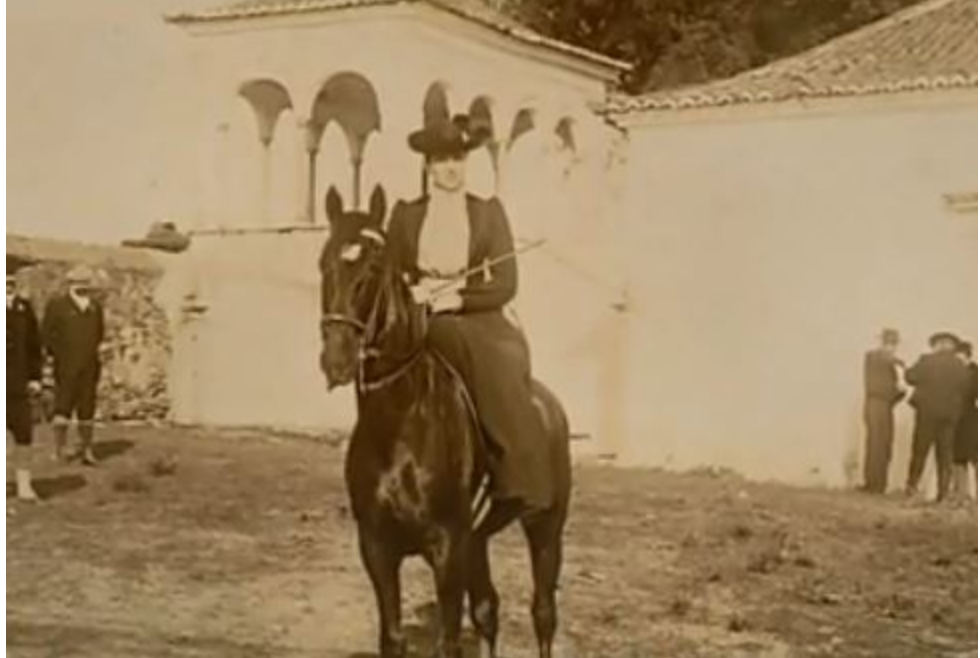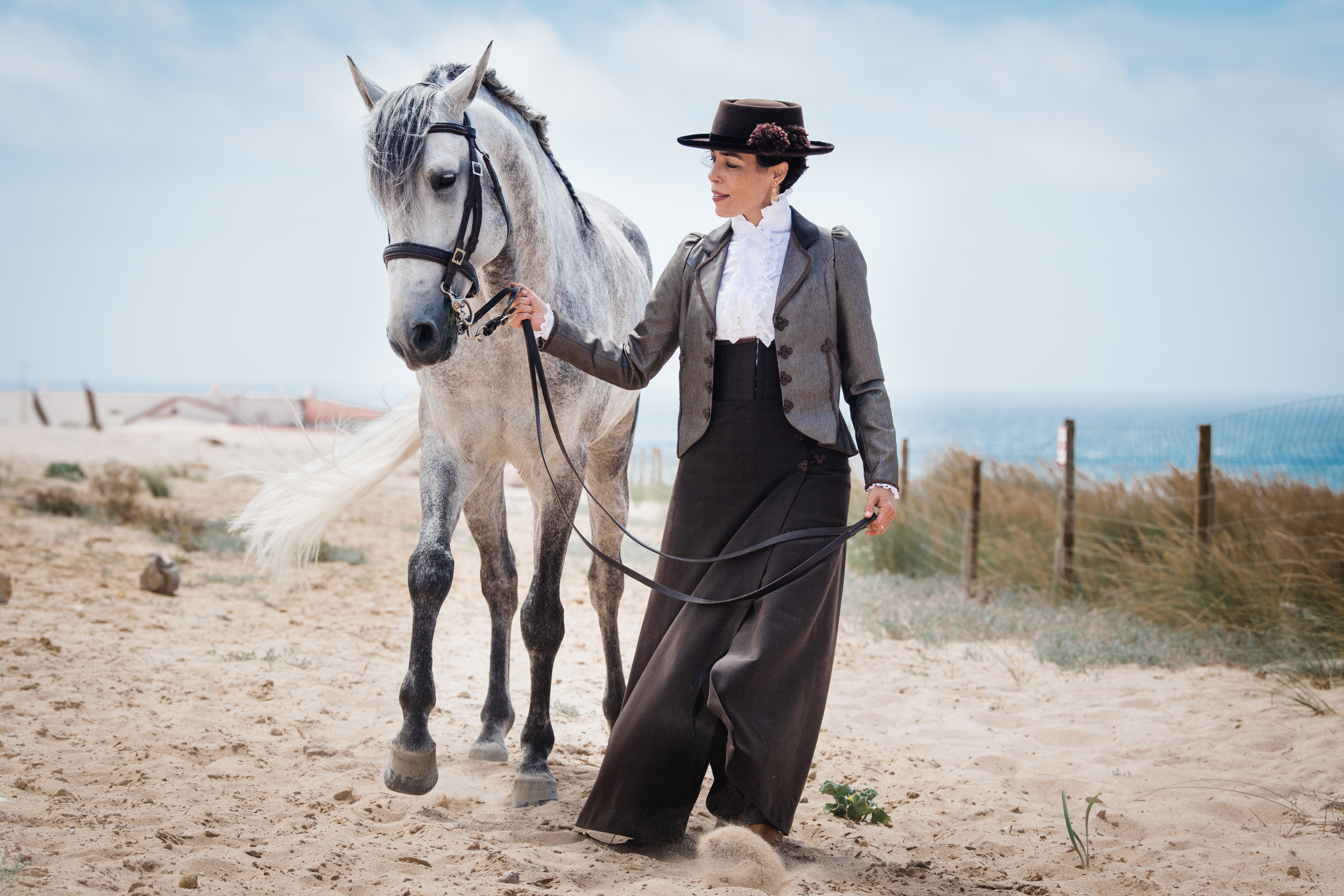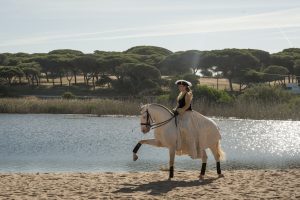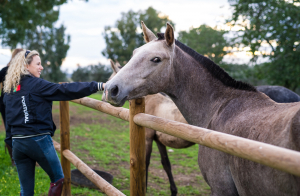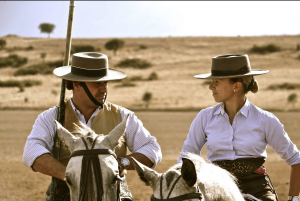These are articles about classical dressage with riding and working from the ground how to, tips, ideas and suggestions from different contributors
Diablo – A Legend
/in Articles, Classical Equitation, Uncategorised, Frontpage Article/by Teresa BurtonClassic Double Bridle 3:1 Rein Hold
/in Blog, Classical Equitation, Uncategorised, Frontpage Article/by Teresa BurtonThis technique is the oldest method of holding double reins a style used by the Spanish Riding School in Vienna and by many of Germany’s most successful professional riders used it before WWll. It is the –
Classical 3 to 1 method to Holding the Double Reins (3 to 1 Rein Hold)
I first came across this technique when I was watching my dear Friend Master rider Anton Walliser training his and young and GP horses using this method I was fasinated to understand more about it and why he uses it.
How to Hold the Reins Using this Method
The left hand holds three reins, while the right holds only one rein plus the rider’s cane or whip. The correct placement of reins in the left hand is to hold the left snaffle (bridoon) on the outside of the little finger, the left curb rein between little finger and ring finger, and the right curb rein between the ring and middle fingers. The right hand holds the right snaffle (bridoon) rein in the traditional position between the right little finger and ring finger to keep the mouth mobile. The left hand is held more to the center of the horse directly over the withers than off to the left of the withers.
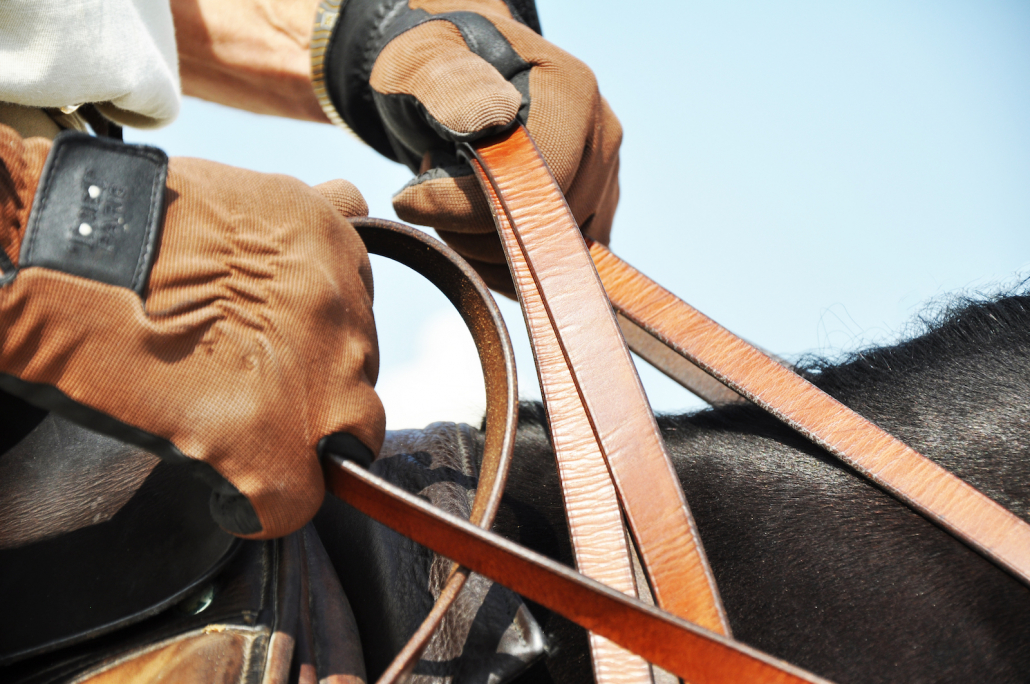
As I understand when using this method it decreases the action of the curb, prevents the rider from riding with their hands too wide and it shows when the horse is not really straight, because the rider can no longer make the rein pressure on one side of the mouth any stronger than the other, since reins from both sides are held in the left hand. The rider must ride off the seat and legs to bend the horse, and the horse must therefore be correctly working“through”.
Also it forces the rider to hold his hands absolutely quiet and encourages a quiet seat as the bending of the horse should be done mainly by the seat. An uneven contact or a crooked horse is easily revealed with this kind of double bridle handling and cannot be hidden by an uneven use of the curb rein.
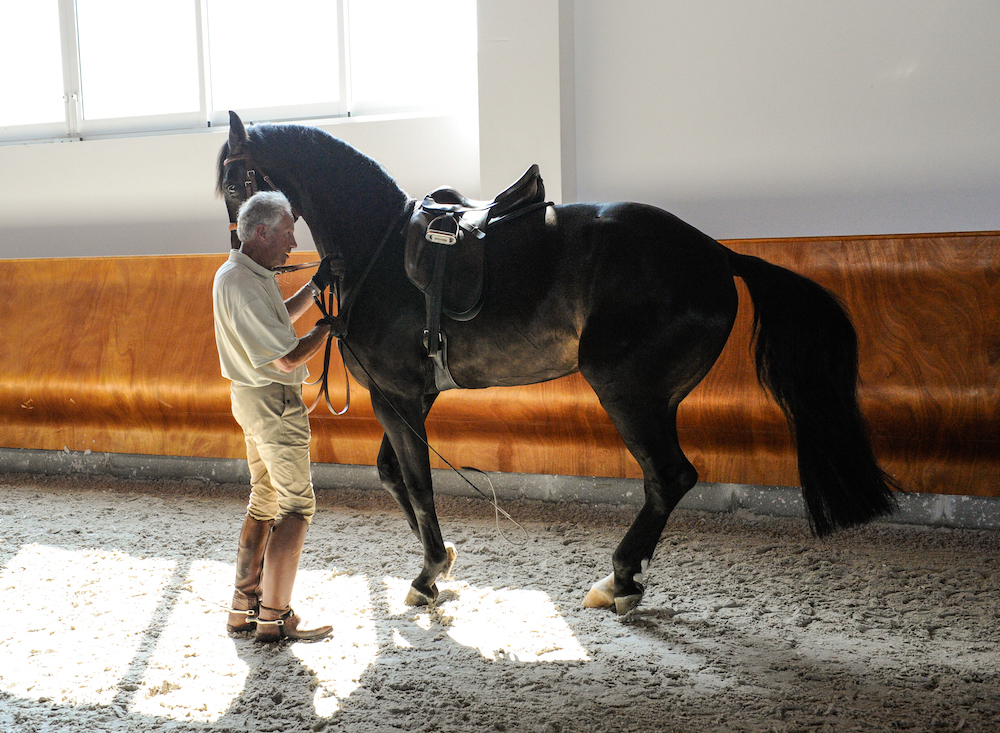
Anton´s comments in addition to my understanding
“I basically agree with your description of the 3 to 1 method. I find it to be a far more effective method in training horses. 20-30 years ago Swiss and German riders were competing their horses using this way but nowadays I don’t see anyone using it. I think maybe because it is much more difficult to learn than the 2 to 2 method used by everyone today.
Learning it takes a lot of practice and patience but the results speak for them self – horses and riders progress much better. It really helps in training your horse to be straight, you have a much more even contact on the curb, never any sudden movements of jerking the curb. The hands are much more together, much quieter and certainly you are riding far more with seat and legs. The horse bends better round your leg your seat will be quieter. The horses stay lighter and more through. I don’t know where this method started but I think it is sad that it is rarely seen used nowadays because if mastered the technique is far better for horse and for the rider”.
I think it would be interesting to learn this method and certainly if it is gentler for the horse and encourages a better seat it cannot fail to be a bonus!
Anton Walliser is my opinion a true Classical Master and has a fasinating story which you can read part one here
There will be part 2 in his story coming soon as now his young horses are all at PSG and above two competing GP and achieving outstanding results. Anton is a true inspiration keep posted.
Other intersting articles – the Classical Masters and The History of Classical Equitation
Text by Teresa Burton 2 images of reins held by Anton Walliser by Teresa Burton
Image of Anton Walliser working his mare from ground to train piaffe by Lena Saugen photography
Further sources – Wikipedia
#2 Portuguese style – “à portuguesa”
/in Blog, Portuguese Equestrian Heritage, Classical Equitation, Portuguese Artisans - Handmaking Equestrian items, Uncategorised, Frontpage Article/by Teresa BurtonThe History of Fashion
The Portuguese Riding Costume
D. Amélia de Orleães e Bragança
The Feminine Costume
But the traditional Portuguese feminine riding costume has much to say!
It is my belief that the majority of the horsewomen who dress in the Portuguese style prefer a more minimal and contemporary costume, and as a result, the traditional feminine costume with its puffed sleeves was set aside and did not earn a solid place as did its pair.
Costume Evolution
Could Working Equitation be an Olympic Sport!
/in Portuguese Equestrian Heritage, Classical Equitation, Frontpage Article/by Teresa BurtonEquestrian Haven in Algarve
/in Classical Equitation, Equestrian Holiday Locations, Uncategorised, Frontpage Article/by Teresa BurtonClassical Equitation in the Algarve
Algarve, is the southernmost province of Portugal, famous for it’s breathtaking mediterranean coastline, hot summers and mild, short winters, its friendly, laid back people, top golf courses, delicious traditional cuisine and stunning scenery.
We have discovered in the heart of this exotic area there is a equestrian escape where you can enjoy beautiful, well trained Lusitano horses and have a great riding experience.
The WOW Factor
The riding establishment called Centro Equestre Lusitanus is owned by the charming couple, João Pedro and Iris Miranda. To find out more we arranged to meet João and Iris one very early morning at a fabulous beach where a wide river meets the ocean. When we arrived João and Iris were already waiting for us with two handsome, braided Lusitanos – a stallion and a mare and what’s more our hosts were dressed up in 18th century costumes. So all we could say was ‘Wow’, what a first encounter!
 Needless to say, it all made for a wonderful photographic opportunity, we had so much fun. Once finished we followed them back to their riding centre Quinta das Cinco Ferraduras – The Five Horseshoe Farm.
Needless to say, it all made for a wonderful photographic opportunity, we had so much fun. Once finished we followed them back to their riding centre Quinta das Cinco Ferraduras – The Five Horseshoe Farm.
It is clear that João Pedro and Iris’ are both passionate about everything equestrian, both have been riding since they were very young and decided very early in life that they wanted to have professional equestrian careers. João Pedro is from Vila Franca de Xíra close to Lisbon, where he was fortunate to have several years of training with grand classical master, Luís Valença, he performed regularly in the famous Valença shows. Later on João expanded his knowledge within the German doctrine and developed the competition side of his riding with the army in Mafra. Here João Pedro obtained his riding instructor status, in fact he was ranked first in his course 2002. João Pedro stayed with the military school as a riding instructor for some years and also had the opportunity to take part in their shows and compete in several disciplines. Iris is from Algarve but at the age of 15 she moved to Vila Franca to attend the Equine Management course, which then led her to be a riding instructor by the Portuguese Equestrian Federation. Iris has also for many years competed successfully in dressage at national level.
Four years ago, having worked with Lusitano breeders and at a variety of different riding centres, João Pedro’s and Iris’ lives took a whole new direction. They came together with business partner Ana Afonso Mateus to take on the riding school where Iris rode as a child, Quinta das Cinco Ferraduras. Grabbing the opportunity they began to build the foundations for their own classical riding centre.
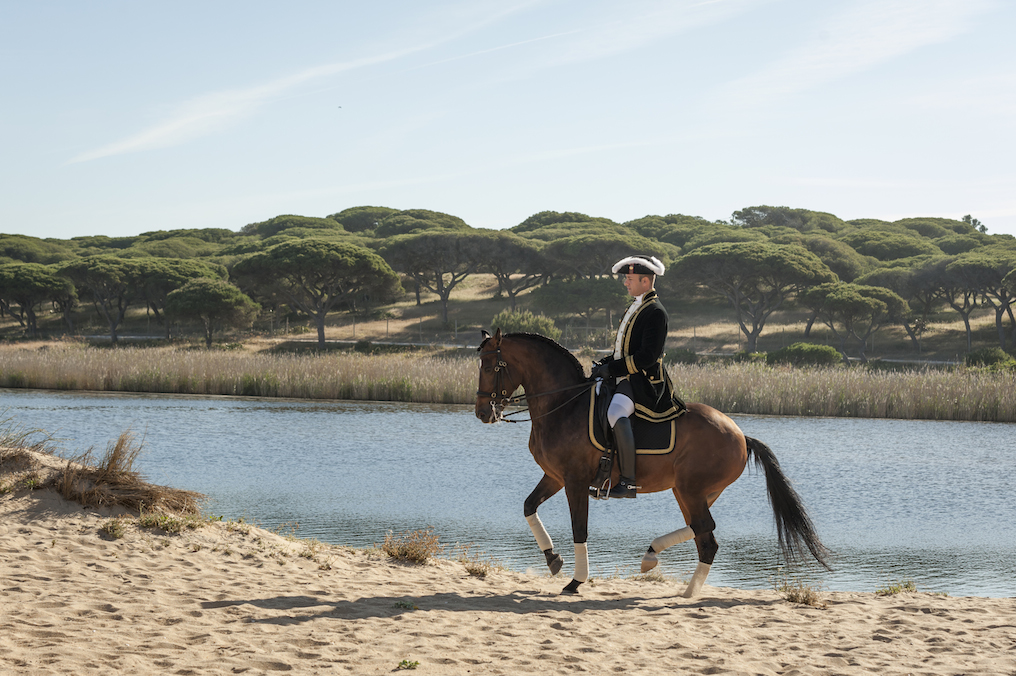
I could not help but feel inspired by this lovely couple and all they have achieved.
In fact even while we were chatting there was a hive of activity in the stables, six horses, three dark and three grey, was being prepared. It turned out João Pedro and Iris had planned to give us a classical display together with four of their students. We were led down to the spacious outdoor arena where we could sit back and enjoy a show seated on beautiful old stone seats under the shade of lovely trees. It was great, we were made to feel really special.
After the show we visited the closest town, Loulé, for a very pleasant lunch at a vegetarian restaurant with a wide range of freshly pressed fruit drinks.
The afternoon plan was to see Iris and João Pedro give some of their students dressage lessons as well as learn more of the competition side of their riding. They showed us well trained horses of various ages and educational levels.

Great Bonus
The day ended with yet another surprise, an in-hand display in the indoor arena, a horse was elegantly shown in piaffe, spanish walk, levade and pesade by João Pedro together with a student. When it was time to leave we were feeling really satisfied with all we had experienced – João Pedro and Iris really managed to show their diversity, we can’t wait to visit them again.
Both João Pedro and Iris are qualified riding instructors in the Portuguese Equestrian Federation, national dressage judges, competition riders as well as directors and riders of their superb classical shows. All the horses at Centro Equestre Lusitanus compete in dressage, many at a high level.
Centro Equestre Lusitanus
even has their own dressage team made up of riders at all ages who are competing successfully in the regional championship. Alongside this the students and all horses regularly take part in the classical shows and displays.
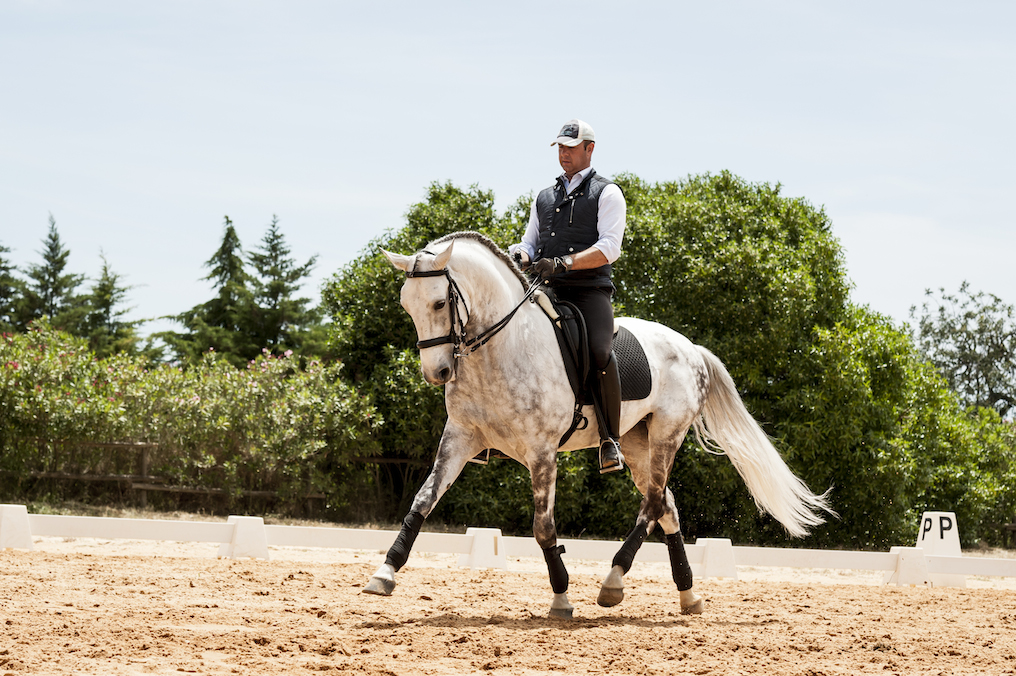
The riding and training philosophy at Centro Equestre Lusitanus -is a fusion of classical and competitive dressage principles, as João Pedro says:
“Our riding philosophy respects the very best of what each riding discipline offers in competition dressage and classical dressage. In applying methods and techniques from each style our goal is always that the horses are calm, forward going, straight with impulsion, flexibility and execute the exercises correctly”.
João Pedro explains
that they devote much of their time to training of horses and students, their aim is to promote the practice of good horsemanship and to promote the qualities of the extraordinary Lusitano horse which by many is considered the world’s best saddle horse.
Today João Pedro and Iris have 27 horses in their care out of which almost all are Lusitanos ranging from youngsters to horses established at Grand Prix level. Many of the horses are also to trained to perform movements not executed in the competition arena such as spanish walk, levade, bows and more.
The equestrian holidays
offered at Centre Equestre Lusitanus place the needs and wishes of the clients at the front. With João Pedro and Iris it is all about flexibility so their holiday riding programs are all carefully tailored, each riding package is designed based on the wishes of client. During your stay you can have –
- Classical dressage lessons
Long reins work in hand lessons
Specifically dedicated dressage lessons with corrective exercises
Competition tips and exercises
Riding Out
There is also the possibility to hack out in the beautiful surroundings and even beach rides when the season allows it. All of this can also be combined in whatever way you may wish for. Riders at all levels are welcome to stay for however long they want and to have as many lessons per day as they wish.
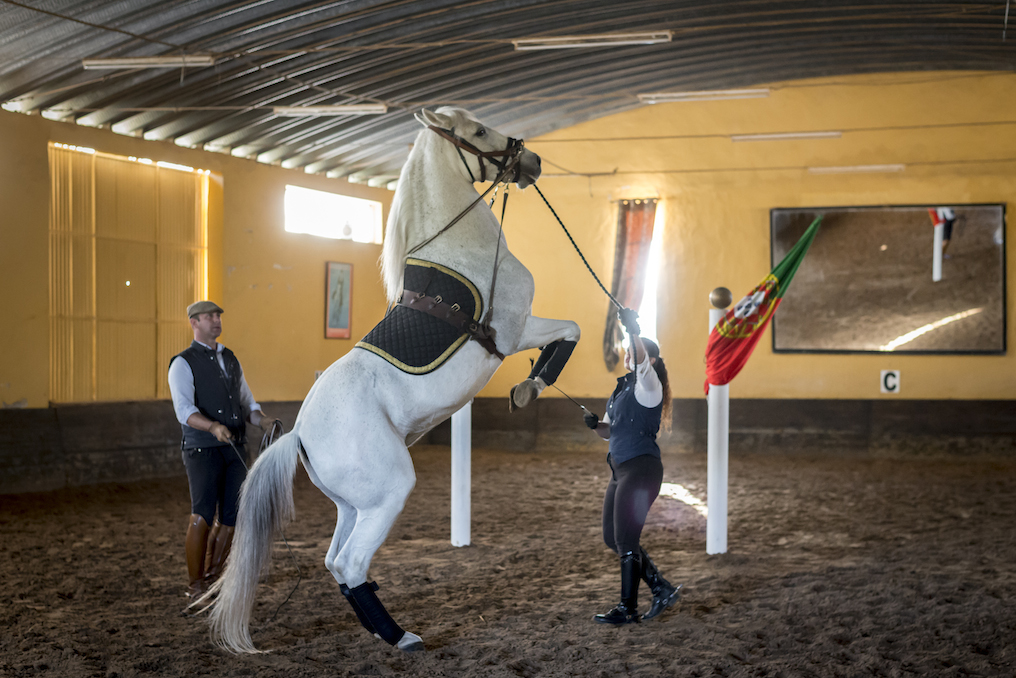 Centro Equestre Lusitanus is situated at Quinta das Cinco Ferraduras, in Loulé in the centre of what is often referred to as Algarve’s Golden Triangle.
Centro Equestre Lusitanus is situated at Quinta das Cinco Ferraduras, in Loulé in the centre of what is often referred to as Algarve’s Golden Triangle.
The Golden Triangle is made up by the towns – Vilamoura, Quinta do Lago and Vale do Lobo – known for having some of the best beaches in the world, great golf courses, and fabulous cuisine with fresh fish available at more or less every restaurant. You can go surfing or visiting Vilamoura Marina – it’s regarded as one of Europe’s best – or why not take a trip to one of the many small, old, villages with narrow cobbled streets and visit the local market or find a small hidden restaurant where sardines are grilled out on the street.
Centro Equestre lusitanus
is only 15 minutes away from Faro airport and the accommodation for your stay is too flexible. Algarve is not short of hotels and golf resorts, João Pedro and Iris have good collaboration with a vide range of places to stay, all from local accommodation in Loulé a few kilometres away from the beaches, to four and five star hotels and resorts, you choose what suits you best. They help with airport transfer, car rental, and if needed, and within distance, they can take you to and from the riding centre during your stay.
We hope to see you soon riding in Portugal’s southernmost region.
BOOK YOUR HOLIDAY WITH US
To find out and book your holiday email us with your requirements
- Length of stay
- Type of lessons and how many
- Type of accommodation
Editorial by Hanna Larsson and Photography by Bruno Barata first published 2015
Paulo & Maria Caetano Part 2
/in Classical Equitation, Frontpage Article, Interviews - riders, breeders and related people/by Teresa Burton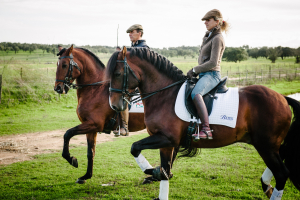
Maria Caetano – interview 2014
Maria is petite, pretty, intelligent and an extremely capable she rides Grand Prix dressage internationally and is not afraid to gallop across rolling hills rounding cattle. She is highly focussed and professional in her career never missing a day with the horses. I was really interested to learn how she developed her equine passion.
Maria you are doing just great in dressage competing Internationally and you were in the World Equestrian Games this year. We would love to know more about your life, your dreams and what it is like being trained by your famous dad. What age did you start riding?
I don’t remember the first time I sat on a horse. Since my first year I had been on a horse’s back with my dad. But I do remember that the first time I rode a horse by myself in the Golegã fair was at the age of 5.
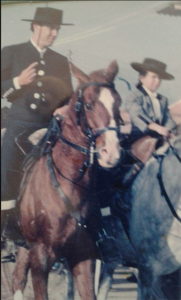
I started competing when I was 13 in small dressage competitions and the Portuguese traditional equitation competitions. But it was in the Working Equitation that I started the serous competition, I was 14 years old.
Do you have any funny stories of your early days riding? Did you and your brother get on or did you compete with each other?
I always had a big passion for bullfighting and riding out in the fields with cows. So, since I was very young (10 or 11) I used to bullfight small cows with my brother in the fields. I always did it and still do it just for fun. In 1999 when I was 13 years old I did perform 2 real public bullfights. However, despite my public presentation, it was never in my mind to be a professional bullfighter. I always wanted to follow a sport career.
You did very well in your younger years but you then competed on a warmblood how was that for you? Would you like to ride warmbloods now?
I started in the serious dressage competition as Junior. It was when I was in the young riders level that I started my steps into International competition. I chose to compete on warm bloods at that level because, at the time, they were more competitive in movements required for Prix St Georges. So, I competed as YR on White Cedar, a Hannoverian, and we achieved 2 gold medals in the National Championships and we competed 3 times in the European Championships. Then I needed a schoolmaster to help me to get in the Grand Prix and we bought Diamant, a big warmblood from Kasselman stables. He was a great schoolmaster for GP and gave me a gold medal in the Senior National Championships on 2008 and a place on the national team for the European Championships in Windsor 2009.
For me the good horses are the good ones, whatever their breed. However it’s a greater pleasure for me to represent my country on the back of a Lusitano.
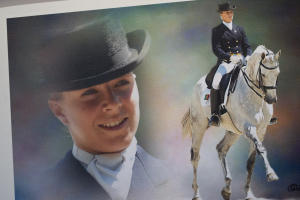
What makes the lusitanos special for you?
What makes the Lusitanos special is the willingness to work and to please the rider. A Lusitano is always trying to understand and help their rider, giving all of him or even more if he can.
You and your father have quite a dynamic relationship how do you like working together?
It’s a big pleasure, a lucky situation, to have my father as a trainer. We work every day together, which is a big advantage. Our relationship is spectacular. He can be strict, but we know that at the end of the day we are father and daughter! I’m so lucky to have a master like him at home!
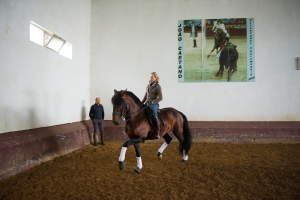
Is all your training with Paulo or do you have others trainers also? Attend clinics etc?
I have had the opportunity to learn from great masters. I spent some of my summer and Christmas holidays in Germany, training with Lisa Wilcox and then with Dolf Keller. I also use to attend to clinics with Kyra Kyrklund and her husband Richard White, Jan Bemelmans and Francisco Cancela de Abreu.
I have seen you and Paulo ride the same horse and I notice differences as would be with any two riders of course but i feel to get on a horse after Paulo has been riding must be quite a feel as he rides very much more classically and has the bull fighting roots. The horses seem very positively dynamic after him I would like to hear you thoughts and comments on the differences for you.
In fact we have the habit of sharing the horses’ daily work with each other. I find that it is very positive that we both ride the same horse since we can share feelings and opinions and then, we can direct the work in a best way. Of course my father has much more experience than me in training horses up to GP. So, he uses his skills, focus and his method in teaching the horses new exercises and I usually focus my method and skills on preparing them for the competitions.
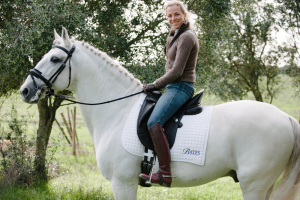
Maria on Xiripiti
Your riding has come from classical principles too how do you find the cross over into modern competition what are the key differences for you if any?
The classical equitation is, for me, the right basis for the sport. Also I always have present in my mind the FEI training scale, I think these are the main tool structure for the horse and the rider combined with classical principles they can bring you and your horse to competition. Nowadays Dressage has developed a lot and the marks increased exponentially, in my opinion we are beginning a golden times of good equitation and I think that riders are coming more and more to the classical principles.
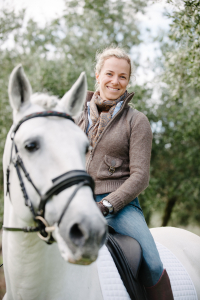 What was it like for you to ride out into the arena at the World Equestrian Games?
What was it like for you to ride out into the arena at the World Equestrian Games?
It was a big pleasure for me to represent my country with a Lusitano at the WEG! I had been before in 3 European Championships as Senior, but in the previous WEG (2010), my horse Util died 5 days before the competition, so I really wanted to be there this year. Unfortunately, Xiripiti was not totally fit, due to an injury he had after the National Championships, he lost some weeks of training before the WEG. Anyway, he did a very clear test, no mistakes, but without his usual strength in the extensions and half passes.
Maria, I guess your next goal is the Olympics and we would truly love to see you competing in them tell us a little about your ambitions we are very interested to know.
I prefer to be focused on the short term, since with horses you have to live day by day, developing your methods and your horse in the daily work and then the results in competition will appear. Anyway, of course that I have some goals in my sportive life, and one of them is the Olympics. Next year I will be focused on the European Championships that will take place in Aachen. A place for a long time now I’ve been dreaming to compete there. Then we will try to be in the Olympics. It’s a tough job to get a place in the Olympics as individual rider, so the first goal will be that the Portuguese team get placed into the 6 first team in the Europeans 2015 and consequently get the qualification, as a team, to the Olympics. I think that it is possible since we have a great group of horses and riders to compete next year in GP level. If it doesn’t happen, then I have to try to get a place as individual.
You told me that you are now very much involved in the horse breeding aspect of your farm how are you making your breeding decisions these days as I believe you are still producing Lusitanos for bull fighting and for dressage competition. How many mares do you have and do you use your own stallions?
We have 15 Lusitano mares we breed for dressage and for bullfight for a long time. I use to say, “when a horse is good is good for everything”. Of course it is not strictly like this but, we always try to find horses with strong backs and legs, with flexibility and “self-carry” and good mind, being always willing to work with the rider. These are essential characteristics for bullfighting and for dressage. Then, we try to use stallions with curriculum in dressage and in bullfighting.
Foals 6 months old
You are not just a dressage rider but a very fun adventurous rider that is not afraid to have some real fun galloping across the Alentejo hills rounding up cattle, and taking part in many Portuguese traditions wearing traditional clothing it is lovely to see this make you very cool in our eyes tell us a little about this side of your life.
I always loved to ride out in the countryside and to work with the cattle. I like to participate, as a hobby, in Acoso y Derribo competitions with my husband. It is a Spanish tradition where two riders have to lead a cow and catch it in the open field. It is really fun and it gives you a lot of adrenaline. We have to have very well trained horses to do it. I can’t imagine having a hobby without horses.
Maria and her ex husband in the fields
I want to thank you Paulo and Maria for your openness in revealing parts of your world, I think you have achieved remarkable things and are a truly inspirational family to know. Many top riders in Portugal are from classical schools of equitation such as The Portuguese School of Arte but very few have bull fighting as their training. What ever ones opinion is about bull fighting – it is an art of great precision and an outstanding horse/rider relationship it is also amazing to hear how a horse can compete PSG one day and bull fight the next. I very much look forward to following your future developments.
Thank you both x
Click here to read Part one with Paulo Caetano
Find Maria Caetano in Facebook
Find Paulo Caetano in Facebook
Text by Teresa Burton and Images by Lena Saugen Photography excluding vintages images.
Interview With Paulo & Maria Caetano
/in Classical Equitation, Frontpage Article, Interviews - riders, breeders and related people/by Teresa Burton
The Most Dynamic Duo
With the ‘hot topic’ debates about modern day competition dressage and classical dressage on so many lips I cannot think of a greater example of this in action than the dynamic duo of Paulo Caetano and his daughter Maria. Two people who live and breathe traditional classical and modern day dressage.
Recently I paid a visit to my friends Paulo and Maria to gain more insight into their lives.
Their home is in the Alentejo, Portugal close to the Spanish border. A long drive takes you up to one of their stunning farms, where the Lusitano horses are bred and trained. The landscape is a timeless scene of rolling hills, lakes, clusters of trees, wild flowers and everywhere is teaming with bird life. Cattle and horses graze contentedly on the lush grass unusual for this time of year, but there has been more rain than normal. The drive winds it’s way to the farm, made up of a house, stables, indoor and outdoor arenas and a breeding facility situated in the middle of the expansive Alentejo views.
When Lena and I arrived we found Maria busy with her sponsors trying out new Bates saddles on her competition horses. I reflected it was only a few weeks before I saw her performing at the world equestrian games on her Lusitano stallion Xirpiti.
Trained by her father Maria is now one of Portugal’s leading stars in dressage competing Internationally. So what makes their story so special so unique?
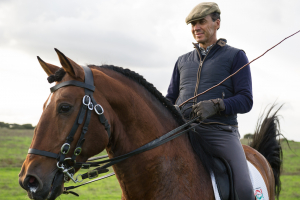
Paulo Caetano riding one of his bull fighting horses on the farm
Part 1 – Paulo Caetano – interview in 2014
Paulo Caetano is a man of great style, a warm smile and engaging manner. He was also one of Portugal’s most well known bull fighters. This year (2014) two riders he trained competed this year in the World Equestrian games in Caen France – his daughter Maria Caetano and Manuel Veiga.
A little bit of History
Paulo´s family were landowners and in 1972 when Portugal’s leader Salazar stepped down from power the army took over running the country in the form of a communist regimé, this situation lasted about 3 years. During this period the Communists aggressively took away the rich manor homes, estates and vast farms from the wealthy to be divided between the people. As a result the banks collapsed and moved their business out of the country. Paulo´s family were among those affected.
Paulo tell us a bit about your family history, childhood and also why did you choose to ride in the bull fight?
Yes both my grandfathers were farmers in Ribatejo and Estremadura regions of Portugal breeding cattle and the black bulls. My father an entrepreneur, worked in Lisbon. He was an amazing business man and a fantastic father. He always respected my dreams to be a rider supporting my decision to become a bullfighter. I was the first person in my family to choose this career.
In 1973 during the Revolution like many I left Portugal, I went to Badajoz in Spain. It was there that my bull fighting career rapidly developed. I made many great supportive friends – I’ll always be very grateful to Moreno Pidal, Alvaro Domeq, Angel Peralta , Fermin Bohorquez, Manuel Vidrié and Jacinto Alcon, all are my true friends for life.
In 1978, I came back to Portugal then my father handed me the responsibility of managing the Esquilas Farm at Monforte, which is still our family’s favourite place to this day.
Even with this new responsibility I continued my passion gaining a lot of success as professional bullfighter. The fights provided me with enough money to develop new agricultural and cattle businesses in our farms plus I bought more land. It was at this time I started breeding Lusitanos.
The Importance of Mentors
At the Monforte farm, my mentor was Antonio Moura, an expert in everything to do with agriculture and cattle. Antonio was the uncle of my college and competitor João Moura and father of the lovely Dita, my future wife.

Paulo and Dita
Meeting Dita has always stayed etched in my mind she used to drive a small scooter to the farm to watch me training. Every day she was in the manége, looking childlike, very quiet, unassuming, a bit shy, but gorgeous.
Two years later we were married and the year after my son João was born. Maria followed three years later. Dita and I have been extremely happily married now for thirty two years.
Paulo at what age did you start bull fighting and what made you choose this life?
I started riding horses at 4 years old and bullfighting professionally when I was 14. I don’t know about choosing it – it’s a passion that has always been in me right from the start.
When I was thirteen I left school and met Antonio Badajoz, one of the most important bullfighting personalities of the time. Although I was very shy I was determined, to say hello to him. To my joy he answered: how are you? Immediately
I replied: I am Paulo Caetano and I want to be bullfighter. Can you see me riding? He laughed, said yes, let´s go.
Three months later I had my first bullfight contract at Campelos – Torres Vedras Portugal 1974.
Paulo at what age did you start bull fighting and what made you choose this life?
I started riding horses at 4 years old and bullfighting professionally when I was 14. I don’t know about choosing it – it’s a passion that has always been in me right from the start.
When I was thirteen I left school and met Antonio Badajoz, one of the most important bullfighting personalities of the time. Although I was very shy I was determined, to say hello to him. To my joy he answered: how are you? Immediately
I replied: I am Paulo Caetano and I want to be bullfighter. Can you see me riding? He laughed, said yes, let´s go.
Three months later I had my first bullfight contract at Campelos – Torres Vedras Portugal 1974.
You mentioned that you had classical training masters that changed you who are they ?
Yes indeed. Concerning my masters I had been a very lucky guy. Antonio Badajoz taught me all about bullfighting the art and rules. He also taught me all the secrets about wild bulls – the Important details about their reactions in the fields and in the arena.
When it comes to the horses and classical equitation my first master, from the age of 4 was my uncle Fernando Metzner Serra. He had German equestrian origins which he openly he shared with me. Then the ones who taught me the fundamentals of classical equitation were the teachings of Pluvinel, Robichon de la Guerinière and Baucher. For me they were the unquestionable masters. I gained all my basic principles from these men.
Grand Classical Masters
My uncle was good friends with the Master of Masters João Branco Nuncio. João Nuncio and Nuno de Oliveira are the most important classical Equestrian`s icons in Portugal. I was very lucky to have the opportunity to go with my uncle Fernando to Vale de Lobos, Nuncio´s farm at Alcácer do Sal. I watched him riding fantastic horses like Ferrolho and Lord Mayor.
The Revelution
During the revolution, two good friends of my father, who lost their farms, came to live in Lisbon. The Viscount da Córte and his best friend and student João Parreira Cano,two very good classic dressage riders I trained with them everyday for 3 years in the classical method.
I’ve always had the desire to make sure I watched and ride with the great masters like Coronel João Martins Abrantes, João Lopes Aleixo and Francisco Cancela de Abreu. They are generous people that have been open and willing to share their knowledge. All of them have given to me knowledge in different ways, but most of all, all imparted the importance of respect and love with the horse.
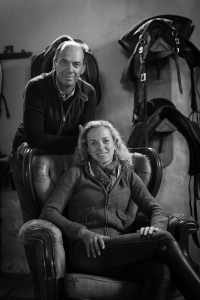
What do you remember most about your early training? Is there something that you always hold true now?
I have been blessed having the opportunity to have so many wise professors They gave me a good and solid base from which to build. Now, 40 years later, I can solve a problem thinking about one of them and their advice. But the most importantly I haven’t stop learning. I know everyday I can learn something new I like to think I am progressing I am not sure but I believe that I am getting better. Certainly each young horse that I start training reminds me : hey you , try to do less mistakes.
Have you any very special or funny memories you would like to share with the readers?
I have so many I don’t know where to start –
In the second Young riders European Championship where Maria was due to compete, her horse, a warm blood called White Cedar, and when he was already traveling to Austria a friend asked Maria to participate in a Prix St. George competition. Maria said to me: I have a problem I want to do this but I have no horse. I said don’t worry take one of my horses. She trained the Lusitano son of Neptuno a couple of days and performed a good PSG test. What people don’t know is that the day after I fought with that horse in a very important Corrida (bull fight). He was one of my best horses.
Maria
In 2006 Maria won the Iberic Cup of Dressage riding a beautiful black Lusitano called Sole Sombra. Fifteen days after, My son and I had one of the most important Corridas of the season. Campo Pequeno at Lisbon. Was the “Alternativa” of João – the day when he became professional. One of best horses went lame. So I started training Sole Sombra. It is a testament to the importance of classical equitation basics they were so good that in two weeks I had him ready for bullfighting. We did a great job in Campo Pequeno Lisbon. One month later I sold him to a dressage rider to Germany. What a horse!
1996 I fought alone 6 bulls bred by me, with Lusitano horses almost all bred by me, and all trained by me.
My Son Joao
In 2012 João follow my steps and fought alone 6 bulls at Monforte, with horses bred and trained by him. It was a very formal occasion and I was dressed in a formal suit. When the the 5th bull arrived João invited me to ride with him, and I did it! Dressed in a suit I rode my favourite horse. The public went crazy.
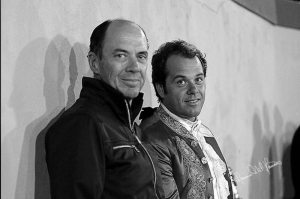 Paulo and his son Joao
Paulo and his son Joao
So Many Things make me Proud
I am very proud of two Lusitano horses bred and trained by me that were selected to the WEG at Kentucky : Util for Portuguese Team and Portugal for Brazilian Team.
I am over the moon with all the Portuguese Championships that Maria has won.
2014 has been a fantastic season for Maria and myself as trainer. She won The Portuguese Championship Gran Prix riding Xiripiti; The National Open Prix St George riding Coroado and the Masters Freestyle with Zingaro de la Lyra y la W. The three most important competitions with three different horses, all of them Lusitanos.
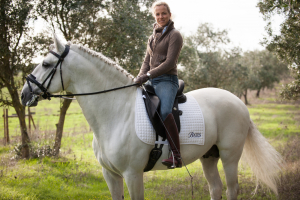
Two riders I trained have been selected to the Portuguese Team in WEG at Caen. My daughter riding Xiripiti and Manuel Veiga riding Benhur da Broa.
Another GP rider Maria Amaral also trained by me gained a really good result in Barcelona and then later won the silver in Open Portuguese Prix St George Championship.
Francisco Pimentel was first in Portuguese Cup Young Horses ( 4YO) riding the beautiful Esquadra MV which is now with my friend and fantastic rider José G Mena.
And all my successful students around the world make me very proud everyday.
Paulo you have two talented children that both love horses and have chosen their careers to be riding. This must be a great pleasure for you. You coach them both in their professional careers – bullfighting and competition dressage. Both are achieving at a high level.
I am very interested in the cross over with classical dressage and modern competition and it seems there is a full circle happening with riders globally looking more closely at the roots of classical equitation. I think you are a fantastic example of crossing the boundaries of classical and modern indeed to coach to people to the WEG is an exceptional achievement especially since you are a bull fighter. Can you talk an bit about how you find the cross over….
To answer this question I think it is fundamental to understand, the history of the Lusitano (Iberian) horse and how Portuguese equitation has evolved. The Iberian horses are very important in our history because it is their functionality that made them very versatile companions, these horses influenced the way forward in our civilization. They started as great war horses offering us amazing combat skills in their agility and ability for collection to produce powerful movements (tricks). Then, later when war was over classical equitation grew from the skills developed in combat. If you assimilate the classical equitation doctrine practised since the “Haute Renaissance” to the Saumur (France), Belém (Portugal), Viena (Austria) and Jerez ( España) you will see the principles. I think it is also very valuable to understand the influence of the German masters too, they were making the bridge between the gymnastic of the horse and the importance of the development of the horse´s body and mind following a intelligent structured method.
Then, it is important to understand and integrate the interaction of the training scales, classical principles and how important is the riders influence on the horse. I feel the training scales act as the bridge between classical and modern. When it comes to classical and modern dressage the basics are the same, although professional dressage training or a professional bullfight training have some very different requirements, different things to achieve, the basics don’t change.
In sport you have to follow a strict development program to build the physical capacities of your horse. It is very important to respect and understand his limits in order to help him achieve the best he can. The sport horse is not a pet. It is an athlete and you must be responsible for his improvement and to stay healthy. To achieve the goal, you have to have a very good eye, to have the capacity to anticipate reactions, the discipline to follow the right way but, mainly, to know which the right way is.
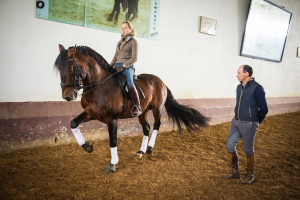
Watching the Master at Work
I noticed when watching you and Maria riding the same horse in the same movements an interesting difference in the horse. The horse worked beautifully and willing with both of you but the level of dynamic is different – not negative just different I am sure anyone can say this of any two riders riding the same horse. However I feel there is another level of difference. As a top bull fight horseman you have amazing skills that are the requirements of such an art, because lets face it when you are in the arena a mistake can cost you and your horse dearly. Most the riding is one handed and often using highly skilled quick lateral movements your seat and thighs are very powerful it is difficult to see anything happening but the horse responds with such a high level of understanding and remains totally in tune with you. A certain level of tension is required is in fact essential this is transmitted from the rider’s body to the horse creating a dynamic connection.
It is fantastic to watch!
I realise bull fighting is a sensitive subject for many and I have no interest in delving into these arguments there are plenty of forums online available for this debate. My interest is in the skills, the art, the horse/rider communication and the classical principles you use. I fully appreciate that is it bull fighting that has meant the Lusitano breed is as fabulous and talented as it is. The bull fighting tradition has ensured Lusitano has survived and is now a breed highly appreciated world wide…. it is people such as yourself that have maintained the horse’s future we thank you for this.
Of course it is not quite the same in dressage competition….. although I am certain some would say the same of the judges it feels like a matter of life or death :-). The riding has some different requirements such as in the contact, the horse’s outline, the walk, extensions etc. Can you talk a bit about how you have managed to cope with all this and what you feel are the most important aspects classical brings to modern competition.
In thanks
Thank you very much Teresa for your kind words. I do my best every day, trying to make less mistakes and always aiming to be the best partner to my horse. I am truly happy with the extraordinary evolution of Lusitano. I believe that we have some of the best horses in the world. I believe that in the near future we will arrive on the podiums in the main international competitions. But the most important thing is to understand the reasons why Lusitano is such a fantastic horse. The main reason is in breeding choices is having the capacity to imagine, to create and to breed a brave, functional horse able to make his rider happy, and be a happy horse as well.
In my opinion in modern competition the most vital classical aspects are the importance of beauty, lightness and harmony. We must keep this.
To ride a horse making invasive movements towards a wild bull who is attacking you, is truly special. The flexibility, the impulsion, the confidence, the collection, all these fundamentals are there. Equitation as a vital function, able to defend your life. It is an incredible feeling as rider. To know, without reservations, that your horse is as a true partner completely with you. When we taste this emotion nothing else can compare. Bullfighting has been through many different times. In 70´s and 80´s in Portugal a good bullfighter was so famous they were like Cristiano Ronaldo is now.
When you get inside this extraordinary world you forget all the rest. If you can read Hemingway, Camilo Cela, Vargas Losa or Garcia Marquez then you can understand it better.
On the subject of opinions about bullfighting, I don’t know. I am comfortable with my career, my challenges , my future goals , my horses, the riders training with me. My family respect and love horses. We love our job. About the future only God knows.
We all are blessed people. Nowadays, we can see the best horses, the best riders and the best judges ever.
You have a fabulous estate in the Alentejo and you still breed the black bulls and lusitano horses. Do you still mostly compete with your own home bred horses? How much has Maria going into competition dressage influenced your horse breeding decisions? What bloodlines do you use?
To compete with horses bred by us is a permanent and extraordinary objective.
I am very proud that now I have the three best Lusitanos bred by me: three 4 year olds – Flamenco, Fogo and Falcão. Amazing horses. I am very motivated by them. My first concern in producing good GP horses is the power, the strength, good character and generosity in spirit.
I know my mares very well. Concerning the stallions, I always go to horses that give me high results and scores. Because this is the best proof of their quality.
Stallions – I love Altivo ( PC), Neptuno ( Veiga), Hostil ( G Borba) and Qualificado ( Coimbra) bloodlines. Rubi can be a good option and Coroado his son is becoming a star.
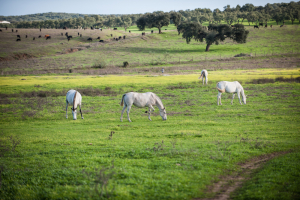
I am sure you and Maria are aiming for the Olympics and we would very much like to see you there. What other plans, goals do you have?
Next goal is the European at Haacchen. In 2015 we´ll have three horses in GP: Xiripiti, Zingaro andCoroado. We also have some exciting new cards to play very soon. So our first goal is to work hard and then try to deserve to be in the best competitions.
Thank you Paulo always a pleasure to spend time you and your family.
Click here to read Part two with Maria Caetano
Text by Teresa Burton and Images by Lena Saugen Photograhy
Classical Riding Club 21st Anniversary Dressage Event
/in Classical Equitation, Frontpage Article, News/by Lusitano-admin1A Proud Day
I am very proud and honored to be invited to be one of the 5 selected presenters at the Classical Riding Club 21st Anniversary Dressage Event in Bedford UK on 30th July this year. What’s more I am alongside some top people what a great privilege!
- Colonel Christian Carde – former Chief Instructor of Cadre Noir Saumur France
- Nuno Cavaco – Rider of the Portuguese School of Equestrian Art
- Sylvia Loch- Accredited Instructor of the Portuguese National Federation
- Patrick Print OBE – Fellow of the British Horse Society & Director of Horse Scotland
- Uwe Spenlen – Former FEI Judge and Member of German Judges Association
I think the event will be amazing, definitely worth attending if you can. I cannot wait to get there. I hope to see many friends and students and meet lots of new people.
If you want to come along I recommend to get in touch quickly so go to http://www.classicalriding.co.uk/the-classical-riding-club-21st-anniversary-dressage-event/
Looking forward to it.
Nuno Cavaco
Key Pages
Supporting The Brooke Organisation
 Lusitano Horse Finder is proud to support The Brooke Organisation, an international animal welfare organisation dedicated to improving the lives of working horses, donkeys and mules in some of the world's poorest communities.
Lusitano Horse Finder is proud to support The Brooke Organisation, an international animal welfare organisation dedicated to improving the lives of working horses, donkeys and mules in some of the world's poorest communities.Get in Touch
Teresa Burton
Malveira, Portugal
Tel: + 351 913 175 772
E-mail: teresa@lusitanohorsefinder.com

